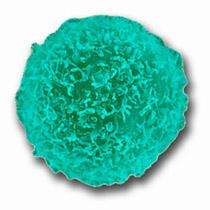A human T-cell. Image: AJ Cann
(Medical Xpress)—A team of researches with members from institutions in Switzerland and the Netherlands has found that multiple kinds of human helper T cells can leap into action against a single pathogen. In their paper published in the journal Science, the team describes how they tested the differentiation of CD4+ helper cells against multiple types of pathogens and found that multiple types of cloned helper cells joined the fight against the intruder.
When the body detects an intruder, the immune system jumps into action, whether its bacteria, virus or even a foreign body, several types of so named CD4+ helper cells spring into action in the impacted area, such as when a virus enters the lung or a dirty nail pierces the skin. Prior research has shown that there are certain types of such helper cells that are called into action depending on the threat. In this new effort, the researchers found that more than one kind of helper cell can dominate the defense attack sent to repel whatever type of invasion has transpired.
T helper cells are actually a specific type of T cell—their job is to help in whatever activity a regular T cell is engaged in while combating a threat. They do so by releasing cytokines—proteins that are critical to cell signaling. More specifically, their job is to regulate the response. In this new effort, the researchers wondered if more than one type of helper cell was truly involved in regulating a response to a given threat. To find out, they tested the differentiation that occurred as human CD4+ helper cells were presented with three specific threats: tuberculosis bacterium, the tetanus vaccine and a yeast fungus. They found (by combining antigenic stimulation and T cell receptor deep sequencing) that a single helper T cell could produce multiple kinds of other helper T cells. They describe it as finding that such cells have different frequencies but similar diversity and are made up of not only clones slanted toward a single fate, but also of clones whose progeny have somehow managed to obtain multiple fates, i.e. an ability to offer a variety of types of assistance. The team's findings indicate that there is more diversity in human T cell response than has been previously thought.
More information: Science DOI: 10.1126/science.1260668
Journal information: Science
© 2014 Phys.org




















